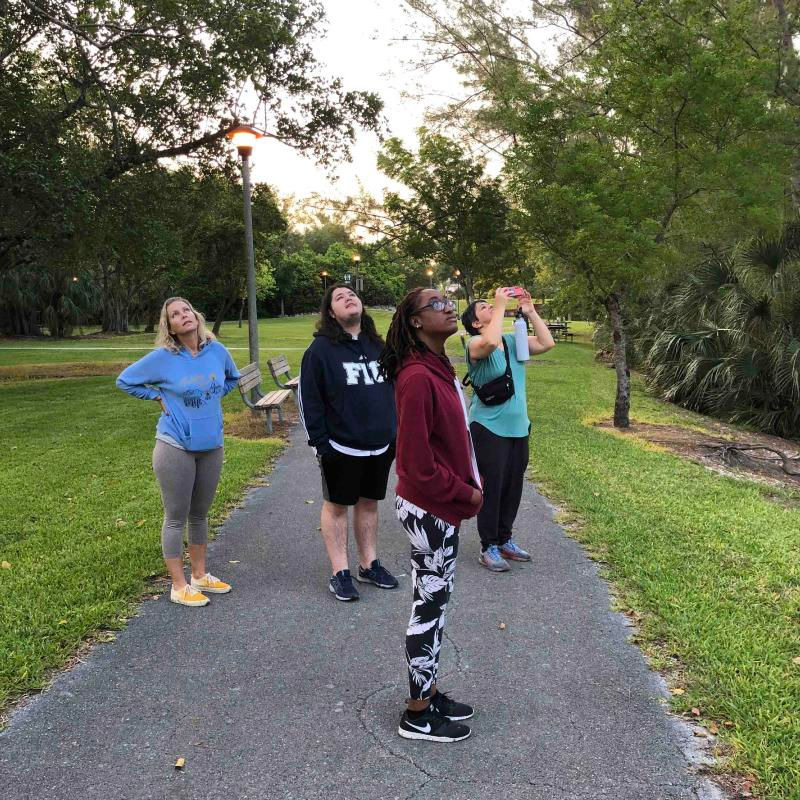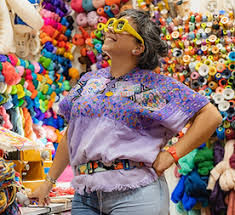FERESHTEH TOOSI
- Anita Sharma
- May 12
- 7 min read
Updated: Nov 22
Solar Salutions
Fereshteh Toosi designs experiences and art objects that pose questions and foster animistic connections. Their artwork often involves documentary processes, oral history, and archival research. Immersive performances are produced in conjunction with small sculptures, short films, installations, scores, and poetry, often situated in gardens, parks, and waterways.
In 2022, Fereshteh developed an augmented-reality audio experience for the Independence Seaport Museum with support from the University of Pennsylvania’s Program in Environmental Humanities. In 2021, they participated in the Montréal/Miami New Narratives Lab hosted by the National Film Board of Canada, O Cinema, MUTEK, and FilmGate Interactive. They also earned a Knight New Work 2020 award for their project Oil Ancestors, and a Miami Live Arts Lab Alliance residency to develop Metaphysical Hotline, a performance by telephone for an audience of one. Fereshteh’s project Water Radio: Liquid Intelligence is a series of contemplative canoe and kayak outings supported by The Ellies Creator Award in 2018.
Fereshteh is an Associate Professor in the digital area of the Art and Art History Department of the College of Communication, Architecture, and the Arts at Florida International University. Before joining the faculty at FIU, Fereshteh held a full-time teaching appointment at Columbia College Chicago for 7 years, the Ford Foundation Faculty Fellowship in Arts and Civil Engagement at Syracuse University, and Visiting Assistant Professor appointments at Saint Mary’s College of Maryland and Frostburg State University, among others.
Documentation of Fereshteh’s artwork and creative research is available at http://fereshteh.net and at http://oilancestors.com
OVERVIEW

Solar Salutations is a series of guided activities and conversations about climate feelings, specifically engaging questions about domesticity and displacement. I’m also completing a solar-powered audio streambox to broadcast the sounds of Miami’s environment to the world.
Why is it called Solar Salutations?
The title is a play on surya namaskar, a well-known kriya (action, deed, effort) in the yoga tradition. Photovoltaic cells created by humans and plant photosynthesis have a lot in common. Plants transform the energy of the sun into chemical energy that fuels the survival of other species. Similarly, human-made photovoltaic cells convert solar energy into electricity.
The project is inspired by a quote by Robin Wall Kimmerer in her most recent book, Braiding Sweetgrass: “Sometimes I wish I could photosynthesize so that just by being, just by shimmering at the meadow’s edge or floating lazily on a pond, I could be doing the work of the world while standing silent in the sun.”
Solar Salutations forges aesthetic connections between the work that plants do for the world, and the human effort necessary to move away from hydrocarbon fuels, such as petroleum, coal, or natural gas which are the primary causes of global warming.
The concept for Solar Salutations has been forming for a few years, and it shifted over time. I first used this title to describe a solar-powered sound art performance I wanted to do for the IKT Miami Congress in 2019. That didn’t happen but I’m happy to be pursuing this new version in tandem with my Oil Ancestors project, which is also supported by Solar Power for Artists.
PELICAN ISLAND PARK

Solar Salutations is a series of guided activities and conversations about climate feelings. How will we resist climate breakdown when changing individual behaviors and consumption is not enough? How does it feel to be living in these times?
The first workshop took place in February on Pelican Island in Biscayne Bay. A group of 7 participants, all in their early 20s, shared their hopes, fears, and dreams about South Florida. The participants were paid a small stipend to support their contributions to the augmented reality audio documentary project.
Often archives and created and situated behind closed doors, but in my work I’m using digital media to bring our stories outdoors where they can directly address place and cultivate our relationship to site. I’m grateful to Artist as Archivist and WAAM for creating a platform to support alternative methods for archiving community stories.

On February 25, we took a short ferry boat ride to Pelican Island Park. As the facilitator, I shared information about the history of the land, and participants introduced themselves by talking about a meaningful object they had brought to the workshop.
Most of the day was dedicated to passionate discussion about climate justice and eco-anxiety, as participants exchanged personal experiences and resources.
After lunch, the group brainstormed a few questions which they used to interview one another in pairs.

Thanks to Ashley, Kasia, Isa, Katherine, Dania, Yany, and Blanche for their participation in this project.
OUTTAKE VIDEO

When I do interviews for my projects, there’s usually a lot more to the conversation that doesn’t get included in the finished piece. An interview recording may be an hour or more, but only a few minutes end up in the final piece. I would like to share a couple of quotes in reference to documentation and archiving that came up during my interview with Isabella Marie Garcia. Isa is a lifelong Floridian, an arts writer, photographer, and exhibition coordinator.
Since the Artist as Archivist project is a multidisciplinary platform that examines the relationships that exist between art, activism and archives, I’d like to share Isa’s observations about the connection between environmental stewardship and being aware, awake, and present to what’s happening in the world.
“In a way, I want to slow down and like, not document as much in the present moment, as reflecting on something later on, after the fact. Because I think oftentimes when I document the moment, I'm so focused on documenting, I'm not really feeling what I'm seeing, or feeling what I'm experiencing. So I'm slowing down and being more present. I think there's a way to document in the moment where you're not completely distracted by the process. But we're so, again, like, I think with phones, and— I try to do it with my film camera because it's less digital. So I can really just be focused on what the light looks like, in this moment. I'm not having a machine tell me what looks good and what doesn't, or like my phone camera. So yeah, I think it's related in the sense of like less… slowing down and making sure that you're documenting, but you're documenting it is not just a one-stop process. It's like you can think about it after the fact as a reflection
SOUNDCAMP
For the past few years I have participated in Soundcamp, a network of sound and ecology events that take place all around the world annually on Dawn Chorus Day, during the first weekend of May.
Locations are linked by Reveil, a 24+1 hour radio broadcast of live environmental sounds, sent in by streamers around sunrise. This year was the 10th anniversary of Reveil!

I hadn’t been able to host a public Soundcamp since before the pandemic. So as part of Artist in Archives, I invited a small group of people to spend the night at AD Barnes Park. Situated in the middle of an urban environment, the northwest corner of the park features one of the few remaining patches of pine rockland forest ecology in Miami-Dade County, which is a popular spot for migrating birds.
After a homemade dinner lovingly prepared by Neil Brideau, we spent some time around a fire roasting marshmallows and eating s’mores!
Here you see pictured some of the campers who spent the night at a city park and woke up early in order to experience the light and sounds of dawn.
The goal was to use my audio livestream kit and microphones to broadcast the sounds of our environment, but the server for the Reveil project crashed and interrupted this global event. This technical failure was an unexpected but welcome change, allowing us to simply listen and just give attention to our environment without the distraction of any gadgets or gear.
Although some streamers might record their broadcasts, one of the things I love about a livestream is that it can be ephemeral. Live media and live art invites us to rethink the lifespan of documentation and how to breathe life into archives. What motivates our desires to stream, record, and store billions of images, sounds, and data about life on planet earth? While I recognize the value of studying documents from the past and gathering stories to share with future generations, I also want to hold space for listening and experiencing the conditions of our existence in real time.

Even live streaming has a huge environmental impact, so it helps to work with small media (audio uses much less data than video) and renewable energy like solar. Here’s some info about this from the researchers at Simon Fraser University, led by Dr. Laura Marks who also facilitates the Small File Festival.
“Streaming comprises a significant proportion of the carbon footprint of information and communication technologies (ICT), which is calculated to contribute about 4% of global greenhouse gases, about the same as the airline industry. ICT is composed of the data centers, networks, and devices that store, transmit, and display all our social media, videos, photos, and other large files, cryptocurrency, artificial-intelligence applications, etc. All these uses require huge amounts of electricity, and about 79% of global electricity comes from fossil fuels: hence the large carbon footprint.”
TFW
One of the questions that the participants chose to ask each other during the Pelican Island workshop was: “Have you noticed algorithmic bias in climate news and other media?” I did not expect this subject to come up, and it has inspired the way I’d like to continue the different facets of this project.
As a result of my Artist as Archivist project, I began a study group based on feedback from participants during Solar Salutations. Here is an anonymous quote from one of the participants after the Pelican Island workshop:

“My favorite moments were having open back and forth dialogue about our environmental anxieties as a group. I often talk about climate change but have never put a name to the worries that constantly linger in the back of my mind about that topic.”
The study group is called TFW… (that feeling when) and it’s designed as a supportive space for conversation about climate change, wellness, and technology from feminist, queer, anticolonial and racial justice perspectives. As an in-person community aimed at creative people, discussion will focus on the intersection between digital media like AI and NFTs, and environmental issues.
My role as the facilitator will be informed by my experiences as a professor of digital art, as well as my studies of forest bathing / forest therapy, horticultural therapy, and Buddhist philosophy. An example of the works we will engage with together include texts by Ruha Benjamin, Sarah Jaquette Ray, everest pipkin, Mimi Onuaha, Nabil Hassein, and Octavia Butler, among others.
Here's a link to the invitation for the study group:https://www.eventbrite.com/e/tfw-that-feeling-when-study-group-tickets-676939082017




Comments